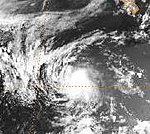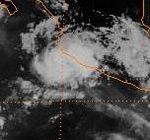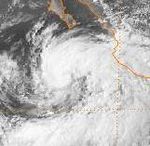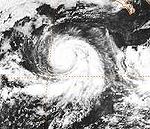1990 Pacific hurricane season
| 1990 Pacific hurricane season | |
|---|---|

Season summary map
|
|
| Seasonal boundaries | |
| First system formed | May 12, 1990 |
| Last system dissipated | November 1, 1990 |
| Strongest storm | |
| Name | Trudy |
| • Maximum winds | 155 mph (250 km/h) (1-minute sustained) |
| • Lowest pressure | 924 mbar (hPa; 27.29 inHg) |
| Seasonal statistics | |
| Total depressions | 27 |
| Total storms | 21 |
| Hurricanes | 16 (record high, tied with 1992, 2014 and 2015) |
| Major hurricanes (Cat. 3+) |
6 |
| Total fatalities | 18 |
| Total damage | Unknown |
| Related articles | |
| Category 1 hurricane (SSHWS) | |
| Duration | May 12 – May 18 |
|---|---|
| Peak intensity | 85 mph (140 km/h) (1-min) 979 mbar (hPa) |
| Category 1 hurricane (SSHWS) | |
| Duration | June 2 – June 8 |
|---|---|
| Peak intensity | 90 mph (150 km/h) (1-min) 977 mbar (hPa) |
| Tropical storm (SSHWS) | |
| Duration | June 8 – June 16 |
|---|---|
| Peak intensity | 65 mph (100 km/h) (1-min) 994 mbar (hPa) |
| Tropical storm (SSHWS) | |
| Duration | June 19 – June 23 |
|---|---|
| Peak intensity | 65 mph (100 km/h) (1-min) 992 mbar (hPa) |
| Category 1 hurricane (SSHWS) | |
| Duration | June 26 – July 2 |
|---|---|
| Peak intensity | 80 mph (130 km/h) (1-min) 990 mbar (hPa) |
| Tropical depression (SSHWS) | |
| Duration | June 29 – July 3 |
|---|---|
| Peak intensity | 35 mph (55 km/h) (1-min) 1007 mbar (hPa) |
| Category 1 hurricane (SSHWS) | |
| Duration | July 6 – July 12 |
|---|---|
| Peak intensity | 85 mph (140 km/h) (1-min) 979 mbar (hPa) |
| Category 2 hurricane (SSHWS) | |
| Duration | July 10 – July 18 |
|---|---|
| Peak intensity | 105 mph (165 km/h) (1-min) 970 mbar (hPa) |
| Category 4 hurricane (SSHWS) | |
| Duration | July 19 – July 31 |
|---|---|
| Peak intensity | 155 mph (250 km/h) (1-min) 928 mbar (hPa) |
The 1990 Pacific hurricane season is the fifth most active season on record and is the third most active season in terms of ACE Indices. The 1990 season officially started on May 15 in the eastern Pacific, and on June 1 in the central Pacific, and lasted until November 30. These dates conventionally delimit the period of each year when most tropical cyclones form in the northeastern Pacific Ocean. However, these bounds were slightly exceeded when Hurricane Alma formed on May 12.
Hurricane Alma became the third earliest tropical cyclone in the Eastern Pacific basin since the satellite era began in 1966, while Trudy is the third strongest October eastern Pacific hurricane on record. Overall, the impact of this season was minimal. Tropical Storm Rachel made two landfalls in Mexico and brought rain to the United States. Hurricane Boris brought light showers to California.
The 1990 eastern North Pacific hurricane season was active in terms of number of storms that attained at least tropical storm intensity and of Accumulated Cyclone Energy. All of the tropical cyclones of this year developed from westward-moving African tropical waves. The season established several tropical storm records for this basin and was marked by several strong hurricanes. There were 21 named tropical cyclones, seven below the record established by the 1992 Pacific hurricane season two years later, but four more than the long-term average. Sixteen of those named storms, twice the average and four more than the previous record, reached hurricane intensity. Only Cristina, Douglas, Aka, Rachel, and Simon did not reach hurricane strength. Six of those hurricanes reached Category 3 intensity or higher on the Saffir-Simpson Hurricane Scale. Hurricanes Hernan and Trudy were among the strongest ever observed in this area. Alma became the earliest named tropical cyclone for the eastern Pacific ocean east of the 140th meridian west. The eastern Pacific produced four tropical depressions that did not reach tropical storm status.
With the exception of Marie and Polo, these systems developed between 5° and 15°N, east of the longitude of Baja California in the climatologically favored area for tropical cyclogenesis. After their development, most of the tropical cyclones moved on a west to northwest track and dissipated over cool waters without affecting land. Rachel was the only system to make landfall. In addition, one tropical storm formed in the Central Pacific and eventually crossed the International Dateline before dissipating.
...
Wikipedia















